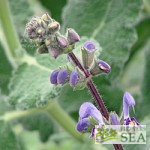(Shangri-la Sage) Take a close look at Salvia moorcroftiana x indica 'Shangri-la' and you'll notice that its lavender flowers have lighter lower lips with deep purple freckles. The tall, branched flower spikes arise from a short mound of large, aromatic, blue-gray leaves that are a bit prickly but so pretty with lightly ruffled edges.
Shangri-la is a singular early bloomer, a perennial that tolerates cold, heat, and drought to bring on a reliable burst of color and fragrance beginning in spring. It's a good addition to dry gardens but thrives with average watering based on the amount of your local rainfall. Similar to most sages, it needs good soil drainage. However, Shangri-la is adaptable to soils ranging from clay to sandy loam. Plant it in a partial to full sun setting.
Shangri-la is a brand of Colorado's Plant Select, a nonprofit collaboration between Colorado State University and Denver Botanic Gardens. Suncrest Nurseries, a wholesaler based in Watsonville, California, discovered it as a chance seedling at one of its properties.
Shangri-la is a cross between the high-altitude species Kashmir Sage (Salvia moorcroftiana) and Two-lip Spotted Sage (Salvia indica), which is native to rocky limestone slopes from 350 to 5,000 feet high in western Asia. In your garden, it will be at home in flowerbeds or containers.
Salvia moorcroftiana is named for 19th century British veterinarian William Moorcroft (1765 - 1825) who collected the plant in the Ladakh region of what is now the Indian state of Jammu and Kashmir. It was published in 1830 by botanists Nathaniel Wallich (1786 - 1854) and George Bentham (1800 - 1884) in Plantae Asiaticae Rariores.
In Latin and Greek, indica means "of India." In May 1753, Swedish botanist Carl Linnaeus (1707 - 1778) published Salvia indica in Species Plantarum.
It's lovely to think about these two immigrants finding each other in 21st-century America. Together, they make great music in Shangri-la Sage, which attracts many a hungry honeybee.






